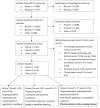Features of Structured, One-to-One Videoconference Interventions That Actively Engage People in the Management of Their Chronic Conditions: Scoping Review
- PMID: 40009439
- PMCID: PMC11904366
- DOI: 10.2196/58543
Features of Structured, One-to-One Videoconference Interventions That Actively Engage People in the Management of Their Chronic Conditions: Scoping Review
Abstract
Background: A dramatic increase in the use of videoconferencing occurred as a response to the COVID-19 pandemic, including delivery of chronic disease management programs. With this increase, clients' openness to and confidence in receiving any type of telehealth care has dramatically improved. However, the rapidity of the response was accomplished with little time to learn from existing knowledge and research.
Objective: The purpose of this scoping review was to identify features, barriers, and facilitators of synchronous videoconference interventions that actively engage clients in the management of chronic conditions.
Methods: Using scoping review methodology, MEDLINE, CINAHL, and 6 other databases were searched from 2003 onward. The included studies reported on structured, one-on-one, synchronous videoconferencing interventions that actively engaged adults in the management of their chronic conditions at home. Studies reporting assessment or routine care were excluded. Extracted text data were analyzed using thematic analysis and published taxonomies.
Results: The 33 included articles reported on 25 distinct programs. Most programs targeted people with neurological conditions (10/25, 40%) or cancer (7/25, 28%). Analysis using the Taxonomy of Every Day Self-Management Strategies and the Behavior Change Technique Taxonomy version 1 identified common program content and behavior change strategies. However, distinct differences were evident based on whether program objectives were to improve physical activity or function (7/25, 28%) or mental health (7/25, 28%). Incorporating healthy behaviors was addressed in all programs designed to improve physical activity or function, whereas only 14% (1/7) of the programs targeting mental health covered content about healthy lifestyles. Managing emotional distress and social interaction were commonly discussed in programs with objectives of improving mental health (6/25, 24% and 4/25, 16%, respectively) but not in programs aiming at physical function (2/25, 8% and 0%, respectively). In total, 13 types of behavior change strategies were identified in the 25 programs. The top 3 types of strategies applied in programs intent on improving physical activity or function were feedback and monitoring, goals and planning, and social support, in contrast to shaping knowledge, regulation, and identity in programs with the goal of improving mental health. The findings suggest that chronic condition interventions continue to neglect evidence that exercise and strong relationships improve both physical and mental health. Videoconference interventions were seen as feasible and acceptable to clients. Challenges were mostly technology related: clients' comfort, technology literacy, access to hardware and the internet, and technical breakdowns and issues. Only 15% (5/33) of the studies explicitly described compliance with health information or privacy protection regulations.
Conclusions: Videoconferencing is a feasible and acceptable delivery format to engage clients in managing their conditions at home. Future program development could reduce siloed approaches by adding less used content and behavior change strategies. Addressing client privacy and technology issues should be priorities.
Keywords: BCTTv1; Behavior Change Technique Taxonomy version 1; TEDSS; Taxonomy of Every Day Self-Management Strategies; active participation; behavior change; chronic disease management; intervention program; mobile phone; scoping review; self-management; videoconference.
©Yu-Ting Chen, Michelle Lehman, Toni Van Denend, Jacqueline Kish, Yue Wu, Katharine Preissner, Matthew Plow, Tanya L Packer. Originally published in the Journal of Medical Internet Research (https://www.jmir.org), 26.02.2025.
Conflict of interest statement
Conflicts of Interest: ML is cofounder and owner of Think Self-Management Inc, an incorporated company that disseminates evidence-based self-management interventions. TLP was an original cofounder with no financial interest. This review was planned and mostly completed before the incorporation of this company, and no publications regarding interventions or programs distributed by Think Self-Management met the inclusion criteria for this review. All other authors declare no other conflicts of interest.
Figures



Similar articles
-
Remote participants' experiences with a group-based stroke self-management program using videoconference technology.Rural Remote Health. 2012;12:1947. Epub 2012 Mar 29. Rural Remote Health. 2012. PMID: 22463728
-
Telehealth Interventions Delivering Home-based Support Group Videoconferencing: Systematic Review.J Med Internet Res. 2018 Feb 2;20(2):e25. doi: 10.2196/jmir.8090. J Med Internet Res. 2018. PMID: 29396387 Free PMC article.
-
Behavioural interventions for type 2 diabetes: an evidence-based analysis.Ont Health Technol Assess Ser. 2009;9(21):1-45. Epub 2009 Oct 1. Ont Health Technol Assess Ser. 2009. PMID: 23074526 Free PMC article.
-
Exploring the Use of the Behavior Change Technique Taxonomy and the Persuasive System Design Model in Defining Parent-Focused eHealth Interventions: Scoping Review.J Med Internet Res. 2023 Jun 21;25:e42083. doi: 10.2196/42083. J Med Internet Res. 2023. PMID: 37342082 Free PMC article.
-
Clients' perceptions and experiences of targeted digital communication accessible via mobile devices for reproductive, maternal, newborn, child, and adolescent health: a qualitative evidence synthesis.Cochrane Database Syst Rev. 2019 Oct 14;10(10):CD013447. doi: 10.1002/14651858.CD013447. Cochrane Database Syst Rev. 2019. PMID: 31608981 Free PMC article. Review.
References
-
- Gelburd R. Telehealth claim lines rise 2980% in one-year period through September 2020. AJMC. 2020. Dec 1, [2024-12-12]. https://www.ajmc.com/view/telehealth-claim-lines-rise-2980-in-one-year-p... .
-
- Orlando JF, Beard M, Kumar S. Systematic review of patient and caregivers' satisfaction with telehealth videoconferencing as a mode of service delivery in managing patients' health. PLoS One. 2019 Aug 30;14(8):e0221848. doi: 10.1371/journal.pone.0221848. https://dx.plos.org/10.1371/journal.pone.0221848 PONE-D-19-06476 - DOI - DOI - PMC - PubMed
-
- Fatehi F, Armfield NR, Dimitrijevic M, Gray LC. Clinical applications of videoconferencing: a scoping review of the literature for the period 2002–2012. J Telemed Telecare. 2014 Nov 16;20(7):377–83. doi: 10.1177/1357633x14552385. https://doi.org/10.1177/1357633X14552385 - DOI - DOI - PubMed
-
- About chronic diseases. Centers for Disease Control and Prevention. [2023-08-03]. https://www.cdc.gov/chronic-disease/about/index.html .
-
- Corbin J, Strauss A. Managing chronic illness at home: three lines of work. Qual Sociol. 1985;8(3):224–47. doi: 10.1007/bf00989485. https://link.springer.com/article/10.1007/BF00989485 - DOI - DOI
Publication types
MeSH terms
LinkOut - more resources
Full Text Sources
Medical

